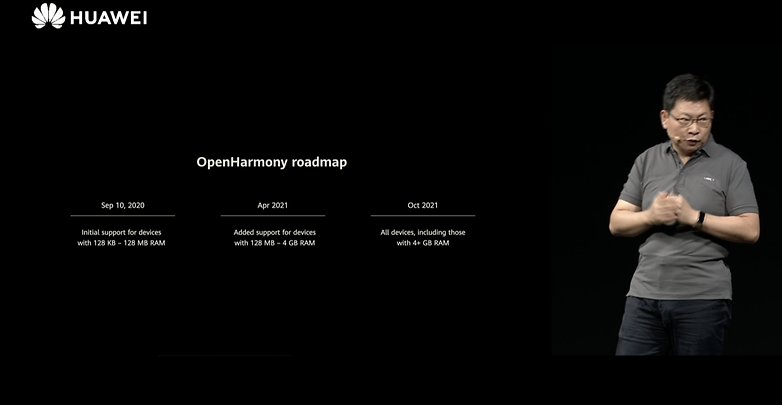HarmonyOS 2.0, EMUI 11: Huawei tiptoes into the post-Google era


Read in other languages:
Huawei is currently hosting its HDC (Huawei Developer Conference) on Thursday, September 10th until this Saturday, and they did provide an update on its product and software ecosystem. The brand new HarmonyOS 2.0 operating system and its EMUI 11 interface are supposed to roll out in due time, signaling a shift from depending on Google and Android into a brand new era.
Richard Yu, head of Huawei's consumer division, began by unveiling plans for the deployment of HarmonyOS 2.0. The open-source code of the operating system will work across the entire range of the Chinese brand's mobile devices, even on those that carry 4 GB of RAM or more, by the time October 2021 rolls around. It can be considered a successful retrofitting exercise should that happen by the deadline, as the OpenHarmony roadmap points to initial support for devices that carry anywhere from 128 KB (!) all the way to 128 MB of RAM.

For Huawei smartphones, a beta will be made available to developers as early as December 2020 in order to prepare the way ahead for the transition. This will not happen immediately and neither will it be as definitive as one might have thought. In fact, not all of Huawei smartphones will be powered by HarmonyOS in 2021 as opposed to Android.
The Chinese giant simply wants to give itself the necessary breathing space by finalizing HarmonyOS, so that it is fully capable of making the leap to its own platform while disconnecting itself from the Android scene completely. However, making this clean break is not the company's primary objective, as Richard Yu hammered home that point numerous times in a subtle manner throughout the entire conference.
"Maybe from next year, we'll have smartphones with HarmonyOS." This remains too vague of a statement of intent to draw any conclusions. But it is certain that HarmonyOS 2.0, which is an OS that will run on all Huawei products, is at the heart of the 1+8+N strategy of the company (1= smartphone, 8= connected objects, N= AI, connected home, services). Could it be a modern-day SkyNet?
EMUI 11 is based on...Android 10
Huawei's keynote switched tempo by turning everyone's attention to EMUI 11, which is a brand new software overlay that is based on...Android 10 and not Android 11. It is a brave risk that Huawei took to go down that route. This means the manufacturer has effectively deprived itself of the new features available in Android 11 so that it has some breathing space to work on its home-made alternatives.
Huawei placed a lot of emphasis on the various animation, promising that it will be more fluid by the time it is ready to hit the ground running - be it launching an application or zooming in within the interface, adjusting the volume level or simply opening photos in the gallery. The whole idea is to implement longer transition animations that are pleasing to your eyes.
Dr. Wang Chenglu introduces EMUI 11 with a refreshed look and features that put you at the heart of the digital experience. #HDC2020 pic.twitter.com/318B1bCsf9
— Huawei Mobile (@HuaweiMobile) September 10, 2020
The biggest additions introduced into EMUI 11 are multi-tasking and multi-windows functionalities. It's an extension of the navigation dock, that tiny button that you can place just about anywhere on the display which replaces the virtual buttons that tend to linger around at the bottom of your screen.
With EMUI 11, you are able to quickly reopen applications within an adjustable floating window, and this window will hover over any active application. You will even be able to open up to two floating windows simultaneously for an even more powerful multitasking experience on foldable smartphones such as the Huawei Mate XS: a must-have feature for power users and one of the best additions in EMUI 11.
Huawei will also throw in another feature into the mix in the form of MeeTime - a feature that brings together both video calls and screen sharing capability between several compatible Huawei devices, where examples include a smartphone and a smart TV, or perhaps a smartphone and another smartphone. This is nothing jaw-dropping as at press time since it is a feature that did appear during the presentation of EMUI 10.1.
The manufacturer also took to the stage to explain how they are working on their own translation and subtitling function, similar to Android Live Caption. This feature will be known as AI Subtitles, enabling you to subtitle any audio content on-the-fly, even if the application does not support subtitles natively.
AI Subtitles will also make it possible to translate English, Japanese, or Korean content directly into Chinese. Huawei explains that more languages will be supported in the future. As with any machine translation software, do take note that you will find the translation to be spotty at best.
The EMUI 11 beta will be available this Thursday in China, where it is offered on the Huawei P40 and P40 Pro, Mate 30 and Mate 30 Pro, MatePad Pro, and two other devices. Apart from that, Huawei also announced that the Honor 30, Honor 30 Pro, Honor View 30, Honor View 30 Pro, and Huawei Nova 7 may also be on the receiving end of the EMUI 11 beta in a second phase rollout.
Also read on NextPit:













